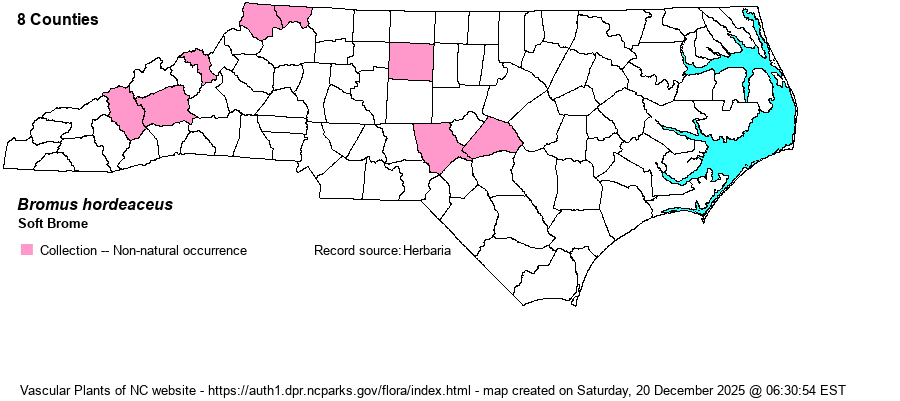| Author | L. | |
| Distribution | Essentially the Mountains only. Recent collection at NCU for Guilford County. Specimens from Gaston, Granville, and Harnett counties need an ID check.
Native to Europe; in N.A. mostly in the Pacific states; in the east, Newf. to southern Ont., south to western NC and eastern TN. | |
| Abundance | Rare. | |
| Habitat | Roadsides, fields. | |
| Phenology | Flowering and fruiting June-July. | |
| Identification | Soft Brome grows up to 2 feet tall, with densely hairy lower stem sheaths. The leaf blades also are hairy, but less densely so, as are the spikelets. The spikelet stalks are less than 10 mm long (vs. 15 mm or more in B. racemosus, B. commutatus, and B. japonicus). | |
| Taxonomic Comments | None
Bromus is an important genus of grasses for their value as forage (many species) or for the harm they cause to the guts of grazing animals (a few species). In most of our species, inflorescences arch over and cause the spikelets to droop; thus the plants are often graceful looking. Bromus, Festuca, and Poa all can look quite similar to beginners (and even veterans!), because they all have multi-flowered spikelets. Generally speaking, Bromus taxa have much the largest spikelets, and most Poa taxa have a tuft of wispy hairs at the base of each floret (lacking in the other genera). Bromus and Festuca taxa have obvious awns on the florets that are absent in Poa taxa. With field experience and careful use of keys, one can eventually handle these genera. | |
| Other Common Name(s) | Soft Chess | |
| State Rank | SE | |
| Global Rank | GNR | |
| State Status | | |
| US Status | | |
| USACE-agcp | UPL link |
| USACE-emp | UPL link |

